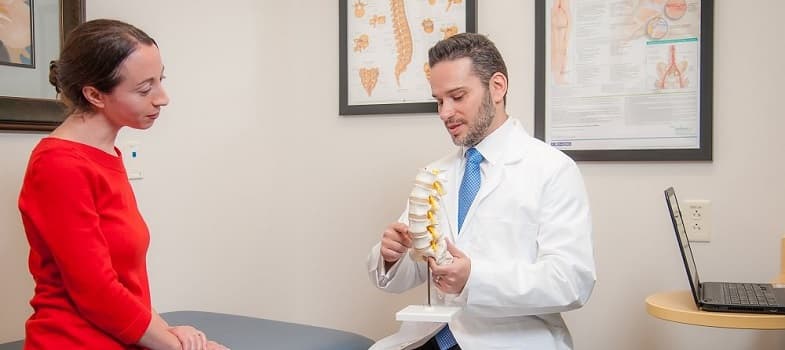What Is A Spinal Cord Stimulator?
There are certain instances when individuals suffer from back pain that is resistant to conventional treatments such as prescription and over-the-counter pain medications, steroid injections into spinal nerves, or physical therapy. When the pain reaches this stage, physicians begin recommending alternative approaches to pain management. A spinal cord stimulator is an alternative form of treatment that is often utilized for resistant pain. Medical advances have led to this innovative approach and it effectively provides patients with dramatic pain relief.
Spinal cord stimulation involves inserting implants into specific locations in the epidural space of the spine in order to regulate pain signals that are transferred from spinal nerves to various parts of the body. The implants transmit mild electrical currents that regulate nerve signal transmission by overriding a nerve’s ability to send pain signals to the brain. Spinal nerves that are inflamed or have become damaged due to an injury often transmit abnormal signals that cause intense, chronic pain. A spinal cord stimulator can correct the abnormal response and thereby reduce pain.
Types Of Spinal Cord Stimulators
The use of a spinal cord stimulator involves the implantation of devices that are made of soft, thin, and flexible wires in order to reduce the occurrence of tissue damage during their placement. Initially, the stimulator is only implanted on a temporary basis and the patient is assessed in a medical facility to determine the level of pain reduction that the stimulator is producing. The stimulator is left in place for a few days to allow the patient to become comfortable with it. If the trial period is successful and produces results that the patient is satisfied with, then a permanent stimulator will be implanted.
A hand-held remote or controller that is connected to the implanted wires is also part of the spinal cord stimulator. The controller allows the pain-blocking stimulation to be activated by the patient on an as-needed basis. In order for the stimulator to specifically regulate certain nerves, the implantable device is inserted along the spinal column near nerves that are responsible for the pain that is being felt. Nerves that are often targeted include cervical nerves that are located in the neck and lumbar nerves that are located in the lower back.
There are a small number of risks that are associated with implanting and using spinal cord stimulators. These include the development of unexpected pain or an infection at the region in the back where the device is installed. In addition, the implanted device may cause scar tissue to accumulate around the wires, but the occurrence of this side effect is low. If scar tissue does develop, it can lead to unexpected inflammation and pain in the nervous tissue that the device was implanted next to. The incision that has to be made in order to insert the stimulator may also cause bleeding and the loss of cerebrospinal fluid. In addition, the spinal cord stimulator may not effectively treat the entire area where affected nerves are located and this may result in partial pain relief. In rare cases, the electrical impulses may cause minor nerve damage instead of simply blocking signal transmission and, if this occurs, a patient may experience a loss of sensation in different parts of the body.

Conditions Related To Spinal Cord Stimulation
One of the first alternate forms of treatment that are used for spinal nerve conditions are steroid injections, which consist of a combination of steroids and an anesthetic to relieve nerve-related pain. The injections typically result in a significant level of pain relief and the effects generally last for long periods of time, up to several weeks or months after the injection. There are, however, extreme cases in which the injections are ineffective or wear off too quickly. In such cases, a spinal cord stimulator may help the patient achieve the level of pain relief that is needed to regain mobility and an enhanced quality of life.
Spinal stenosis is a common condition that has been effectively treated with a spinal cord stimulator. This condition is characterized as spinal nerve compression that is the result of spinal abnormalities or a health problem that has led to nerve damage. Pain that develops after failed back surgery, as the result of the formation of painful scar tissue, can also be effectively treated with a spinal cord stimulator.
Patients who have degenerative disc disease, which is a painful condition that occurs due to the gradual wear and tear of spinal discs, are also optimal candidates for spinal cord stimulation. Furthermore, complex regional pain syndrome, radiculitis, and neuropathy, all of which are conditions that cause intense pain in the extremities, can be treated with a spinal cord stimulator. The device can be implanted near the affected nerves that are associated with each condition.
Research has shown that approximately 75% of the patients who receive spinal cord stimulation experience a significant decrease in their pain. Additional studies have also indicated that spinal cord stimulation may be an effective treatment method for pain related to different forms of cancer.
Conclusion
A spinal cord stimulator is a medical device that is implanted near nerves along the spinal column in order to administer pain-blocking electrical pulses. The pulses regulate the transmission of pain signals from inflamed and damaged spinal nerves in order to reduce pain. The implanted stimulator is usually connected to a remote so that a patient can easily activate the stimulation when needed. A spinal cord stimulator is often recommended to patients who are suffering from chronic pain due to conditions such as radiculitis, failed back surgery, or neuropathy, especially when the pain has been resistant to other forms of treatment. Although a stimulator is more invasive than approaches such as steroid injections, it is a more effective and longer lasting treatment.
References
- Deer TR, Skaribas IM, Haider N, et al. Effectiveness of Cervical Spinal Cord Stimulation for the Management of Chronic Pain. Neuromodulation : journal of the International Neuromodulation Society. 2013;doi:10.1111/ner.12119.
- Rigoard P, Desai MJ, North RB, et al. Spinal cord stimulation for predominant low back pain in failed back surgery syndrome: study protocol for an international multicenter randomized controlled trial (PROMISE study). Trials. 2013;14(1):376.
- Kumar K, Rizvi S, Nguyen R, Abbas M, Bishop S, Murthy V. Impact of Wait times on Spinal Cord Stimulation Therapy Outcomes. Pain practice : the official journal of World Institute of Pain. 2013;doi:10.1111/papr.12126.
- Simpson EL, Duenas A, Holmes MW, Papaioannou D, Chilcott J. Spinal cord stimulation for chronic pain of neuropathic or ischaemic origin: systematic review and economic evaluation. Health technology assessment (Winchester, England). 2009;13(17):iii, ix-x,1-154.
- Xie X, Cui HY, Xu S, Hu Y. Field distribution of epidural electrical stimulation. Computers in biology and medicine. 2013;43(11):1673-1679.
- Padwal J, Georgy MM, Georgy BA. Spinal cord stimulators in an outpatient interventional neuroradiology practice. Journal of neurointerventional surgery. 2013;doi: 10.1136/neurintsurg-2013-010901.
- Frey ME, Manchikanti L, Benyamin RM, Schultz DM, Smith HS, Cohen SP. Spinal cord stimulation for patients with failed back surgery syndrome: a systematic review. Pain physician. 2009;12(2):379-397.
- McAuley J, Aydin Y, Green C, van Groningen R. Patients’ experiences with spinal cord stimulation for lumbar spondylotic pain: comfort at the implantable programmable generator site. Journal of neurology, neurosurgery, and psychiatry. 2013;84(11):e2.
- Manchikanti L, Abdi S, Atluri S, et al. An update of comprehensive evidence-based guidelines for interventional techniques in chronic spinal pain. Part II: guidance and recommendations. Pain physician. 2013;16(2 Suppl):S49-283.
- Lihua P, Su M, Zejun Z, Ke W, Bennett MI. Spinal cord stimulation for cancer-related pain in adults. The Cochrane database of systematic reviews. 2013;2:Cd009389.


